Archived Water Damage Blog Posts
SERVPRO helps school recover from weather-related disaster
8/20/2024 (Permalink)
 SERVPRO of Bloomington responded quickly to dry this newly installed hardwood court at a local school.
SERVPRO of Bloomington responded quickly to dry this newly installed hardwood court at a local school.
In beautiful Southern Indiana, we like to use the saying, "If you don't like the weather today, just wait until tomorrow ... it'll change."
We live in an area of the United States, where we get the pleasure of experiencing all four seasons. From the changing leaves in October to the chance of snow and freezing temperatures in January, the beauty of nature and its seasons is abundant. But it can also be destructive.
When Mother Nature dumped 3.5 inches of rain on our area in a very short time frame, SERVPRO of Bloomington was ready to respond when stormwater overflowed drains at a local school and flooded parts of two buildings, including a wooden gym floor that had been laid within the past year. The school's maintenance crews acted fast, extracting standing water, but called SERVPRO of Bloomington in to dry out the areas.
Our team set equipment after hours, running it over the weekend. SERVPRO of Bloomington was able to dry out all affected areas, quickly and professionally. As the assistant superintendent noted, "I was impressed with their work ethic, communication, and collaboration. They were very professional and hard-working. We appreciate SERVPRO being able to get in quickly and help us with our water issue.
When weather creates a problem, SERVPRO of Bloomington has the manpower and equipment to tackle any-size disaster with professionalism and expertise.
When water damage occurs, call the experts at SERVPRO!
6/27/2024 (Permalink)
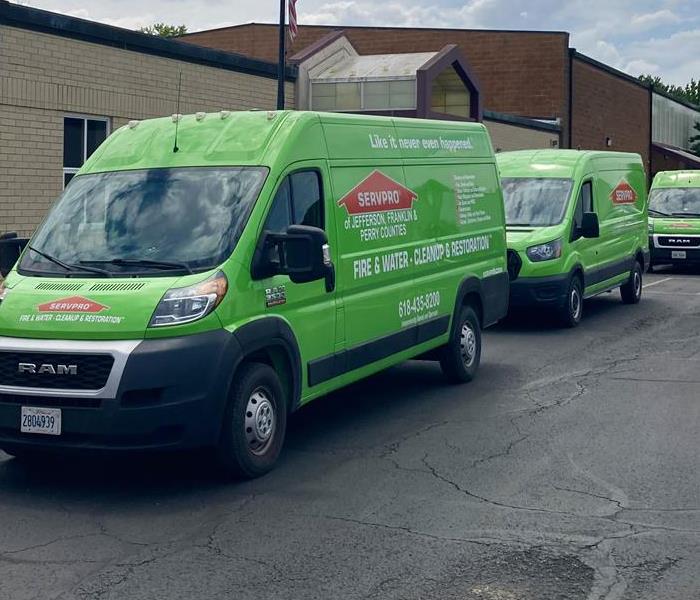 SERVPRO vans in parking lot
SERVPRO vans in parking lot
Water is a force of nature! As beautiful as it can be, it is one of the most destructive causes when it comes to home damage. Often times, it can be going on for months or years before you even notice it. It can cause structural issues to your home or business, as well as severe mold and air quality issues, along with other unwanted problems.
SERVPRO® of Bloomington carries the best equipment to help remove standing water on floors, as well as water trapped inside of walls. Calling SERVPRO immediately after noticing water can also help save hardwood floors from becoming too saturated with water and warping.
Having professional equipment that can dry floors is one of many ways SERVPRO can help save on an insurance claim and help you to get your life back on track quickly!
If you have questions or concerns regarding water damage to your home or business, give the experts at SERVPRO of Bloomington a call at 812-824-2027!
Recovering From Flood Damage | SERVPRO of Bloomington
5/28/2024 (Permalink)
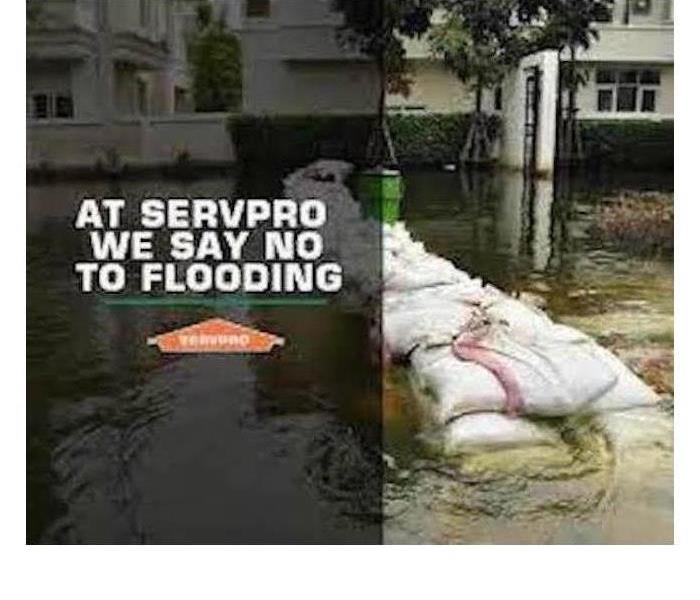 SERVPRO of Bloomington is here to help your home or business recover from flood damage
SERVPRO of Bloomington is here to help your home or business recover from flood damage
Floods can be devastating, leaving behind significant damage to homes and properties. In the aftermath of a flood, it's essential to prioritize safety and take appropriate steps to clean up and restore your property. As experts in flood damage restoration, we at SERVPRO of Bloomington understand the challenges homeowners and businesses face during this difficult time. In this comprehensive guide, we'll share valuable tips and insights on how to safely clean up after a flood, drawing from our experience and expertise in the field.
Safety First
Safety should always be the top priority when dealing with flood cleanup efforts. Before you begin, it's crucial to assess potential hazards and take necessary precautions to protect yourself and your family. Here are some essential safety tips to keep in mind:
- Assess the Risk: Before entering the flooded area, assess the risk of electrical hazards, structural damage, and contamination. If there's a risk of electric shock, turn off the power supply to the affected area before entering.
- Wear Protective Gear: Remember to wear appropriate protective gear, including rubber gloves, rubber boots, and safety goggles, to protect yourself from exposure to contaminated water and debris.
- Avoid Contaminated Water: Floodwater can be contaminated with bacteria, chemicals, and other hazardous substances. Avoid direct contact with floodwater and wash your hands thoroughly with soap and clean water if you come into contact with it.
- Use Caution Around Debris: Be cautious when navigating through the flooded area, as debris and other objects may be submerged and pose tripping hazards.
- Seek Professional Help: If the damage is extensive or if you're unsure about how to safely proceed, seek professional assistance from a qualified flood damage restoration company like SERVPRO of Bloomington
Assessing the Damage
Once you've ensured your safety, the next step is to assess the extent of the damage caused by the flood. A thorough assessment will help you develop a plan for cleanup and restoration. Here's how to assess the damage effectively:
- Inspect the Structure: Carefully inspect the structure of your home, including walls, floors, ceilings, and foundation, for signs of damage such as cracks, warping, or shifting.
- Check Utilities: Inspect electrical, plumbing, and HVAC systems for damage. If you suspect any damage to these utilities, refrain from using them until they've been inspected and repaired by a qualified professional.
- Document the Damage: Take photographs and videos of the damage to document the extent of the flood damage for insurance purposes. Make a detailed inventory of damaged items and belongings.
Removing Water and Debris
Once you've assessed the damage, the next step is water damage restoration. Prompt removal of standing water is essential to prevent further damage and minimize the risk of mold growth. Here's how to safely remove water and debris:
- Use Pumps and Wet/Dry Vacuums: Use pumps, wet/dry vacuums, or buckets to remove standing water from the flooded area. Start by removing as much water as possible to speed up the drying process.
- Dispose of Debris: Remove debris, mud, and silt from the flooded area using shovels, rakes, and wheelbarrows. Dispose of debris properly according to local regulations.
- Clean and Sanitize: Thoroughly clean and sanitize the affected area to remove any remaining dirt, bacteria, and contaminants. Use disinfectants and cleaning solutions recommended for flood cleanup.
- Dry Thoroughly: Use fans, dehumidifiers, and open windows to facilitate drying and ventilation. Ensure that the affected area is completely dry to prevent mold growth and further damage.
Cleaning and Disinfecting
After removing water and debris, it's essential to clean and disinfect the affected area to eliminate bacteria, mold, and other contaminants. Here are some tips for cleaning and disinfecting after a flood:
- Clean Surfaces: Clean and scrub all surfaces, including walls, floors, and furniture, with soap and water to remove dirt and debris. Use brushes, mops, and sponges to scrub stubborn stains and residues.
- Disinfect: Use disinfectants and antimicrobial solutions to kill bacteria, mold, and other pathogens. Pay special attention to areas that came into contact with floodwater, such as floors, walls, and appliances.
- Launder Fabrics: Wash and disinfect clothing, bedding, and other fabric items that have been exposed to floodwater. Use hot water and laundry detergent to kill bacteria and remove contaminants.
- Clean HVAC Systems: Clean and disinfect HVAC systems, including air ducts, vents, and filters, to prevent the spread of mold and contaminants throughout the home.
- Clean and Sanitize Belongings: Clean and sanitize belongings, furniture, and household items that have been affected by floodwater. Use appropriate cleaning products and techniques for different materials.
Restoring and Repairing
Once the cleanup and disinfection process is complete, the next step is to restore and repair the damage caused by the flood. Depending on the extent of the damage, restoration may involve structural repairs, electrical work, and mold remediation. Here's how to restore and repair your home after a flood:
- Structural Repairs: Assess the structural integrity of your home and address any damage to walls, floors, ceilings, and foundation. Hire a qualified contractor to perform structural repairs as needed.
- Electrical Work: Have electrical systems inspected and repaired by a licensed electrician to ensure safety and compliance with building codes. Replace damaged wiring, outlets, and electrical appliances as needed.
- Mold Remediation: If mold is present in your home, hire a professional mold remediation company to safely remove and remediate mold growth. Mold can pose serious health risks and should be addressed promptly and thoroughly.
- Replace Damaged Items: Replace or repair damaged items and belongings that cannot be salvaged or restored. This may include furniture, appliances, flooring, and personal belongings.
Preventative Measures
After completing the cleanup and restoration process, it's important to take proactive measures to prevent future flooding and water damage. Here are some preventative measures you can take to protect your home:
- Install Flood Barriers: Consider installing flood barriers or flood gates to prevent water from entering your home during heavy rain or flooding events.
- Elevate Utilities: Elevate electrical panels, HVAC systems, and other utilities above potential flood levels to minimize damage in the event of a flood.
- Seal Cracks and Openings: Seal cracks and openings in your home's foundation, walls, and windows to prevent water infiltration during storms.
- Maintain Gutters and Drains: Keep gutters and downspouts clear of debris to ensure proper drainage away from your home. Maintain and clean storm drains to prevent backups and flooding.
- Invest in Flood Insurance: Consider purchasing flood insurance to protect your home and belongings in the event of a flood. Standard homeowners insurance policies typically do not cover flood damage.
Conclusion
Cleaning up after a flood can be a daunting and challenging task, but with the right knowledge and preparation, you can safely restore your home and protect your family's health and safety. By prioritizing safety, assessing the damage, removing water and debris, cleaning and disinfecting, restoring and repairing, and taking preventative measures, you can navigate the cleanup process effectively and minimize the risk of further damage. Remember, if you're unsure about how to safely proceed or if the damage is extensive, don't hesitate to seek professional assistance from a qualified flood damage restoration company like SERVPRO of Bloomington. We are here to help restore your home or business from flood damage.
How to Take On Commercial Water Damage to Your Business | SERVPRO of Bloomington
8/11/2023 (Permalink)
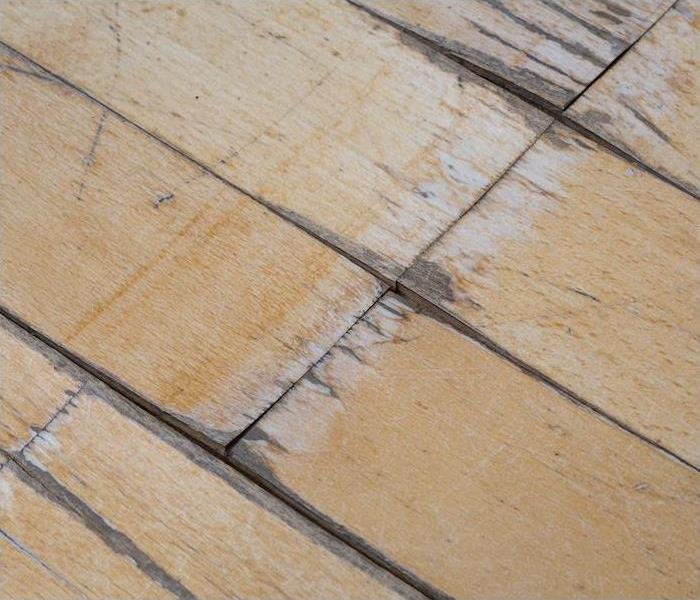 SERVPRO of Bloomington is your local commercial restoration company. We will always be here to help and get you back in business.
SERVPRO of Bloomington is your local commercial restoration company. We will always be here to help and get you back in business.
When commercial water damage affects your building, the impact on business can be severe.
Many sources of flooding come from internal sources. Burst pipes or a badly leaking roof can shut you down or ruin interiors and destroy inventory. Damage might also come from a bathroom flooded with sewage backup. Or it could even be an entire floor of offices soaked by a broken sprinkler system.
However, water damage can also affect businesses through natural causes. In Bloomington, we see a higher annual rainfall than most other places in the United States.
Knowing what to do before disaster strikes make recovering quickly and returning to business easier. Regardless of what source left the water behind, these helpful tips can guide you through handling the problem quickly and as stress-free as possible.
Know Your Building’s Layout
Familiarize yourself with different water cutoff points throughout your property, and ensure you know how to turn off the fire sprinkler system. Locate the main water cutoff valve, and be ready to shut off the entire building’s supply when necessary.
Several people should know this information, including members of the leadership team. This can help you reduce the amount of water that gets inside your business by cutting it off at the source.
Know the Types of Water Involved
When water damage happens, the type of water involved will determine how dangerous the situation is. Knowing what you’re dealing with makes a big difference in the safety of everyone in the building:
White water: This type of water most commonly results from plumbing problems. It’s not considered contaminated and is safe to handle yourself in small amounts.
Gray water: Sink drains and toilet tank overflows produce this type of flooding. The water is contaminated but not considered dangerous.
Black water: Sewage backups and storm flooding are common sources of highly contaminated black water. Always call in a professional to deal with this type of toxic water damage.
Take Action Quickly
Always attempt to identify and shut down the water source as soon as possible. Try to get fresh air circulating by opening windows and doors to expedite the drying and evaporation process. Then alert everyone in the building and outline the affected areas so that no one comes into contact with the water.
After taking these steps, be sure to thoroughly document any visible damage. This will help you speed through the insurance claim process and will be useful when deciding what parts of your building need the most reinforcement.
Remember to Be Patient
The visible water damage in your building is only part of the overall problem. Soaked wall studs, moldy framing and buckled flooring materials are only a few signs of hidden water damage. Any of these indicators should be red flags of potential damage.
If your business experiences water damage, call SERVPRO of Bloomington for a quick response and a shoulder to lean on. Our restoration professionals have extensive training and will work with industry-leading equipment that can dry your building out and get you back into action fast.
The cleanup and drying process can take up to a week, depending on the extent of the moisture, so be patient as our restoration team works through the cleanup and sanitation before beginning repairs. We’ll have your business back to preloss condition before you know it.
When disaster strikes your commercial property, we’ll be there to help clean up and get you back in business quickly. Call SERVPRO of Bloomington today at (812) 824-2027.
How to Deal With Flood Damage | SERVPRO of Bloomington
6/29/2023 (Permalink)
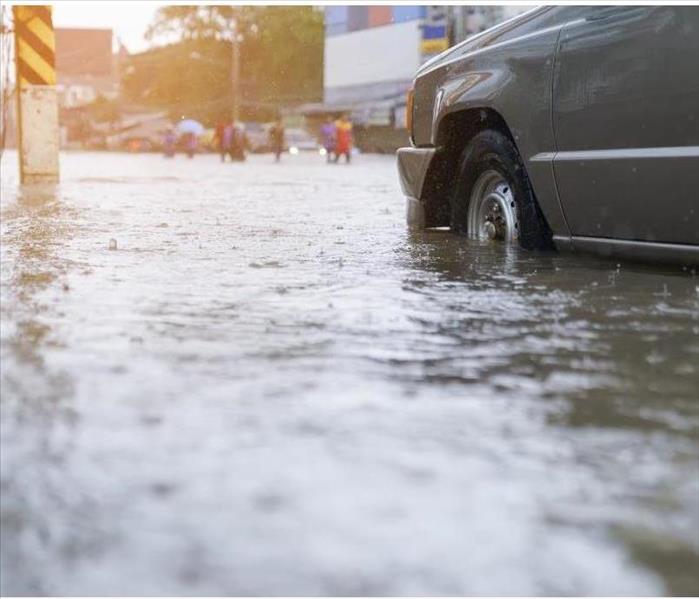 SERVPRO of Bloomington is here to help with flood damage
SERVPRO of Bloomington is here to help with flood damage
Floods can be devastating natural disasters, wreaking havoc on homes and properties. Recovering from flood damage requires a well-structured and organized approach to minimize further loss and restore your property to its pre-flood condition. In this article, we will provide you with a comprehensive guide on how to handle flood damage effectively. By following these steps, you can navigate the restoration process more efficiently and ensure the safety and well-being of your home and family.
Step 1: Ensure Safety
Before entering your home or property after a flood, prioritize safety. Ensure that the floodwaters have fully receded and it is safe to return. Be cautious of structural damage and potential electrical hazards. Wear appropriate protective gear such as rubber gloves, boots, and face masks to avoid exposure to contaminants in the water.
Step 2: Document the Damage
Once it is safe to enter your property, thoroughly document the flood damage. Take photographs or videos of all affected areas, including structural damage, personal belongings, and appliances. This documentation will be invaluable for insurance claims and aid in the restoration process.
Step 3: Contact Your Insurance Company
Notify your insurance company about the flood damage as soon as possible. Provide them with all necessary details, including the extent of the damage, photographs, and videos. Understand your insurance policy and coverage to ensure you are aware of what is eligible for compensation.
Step 4: Disconnect Utilities
For safety reasons, turn off the main power supply to your property. Additionally, shut off the gas and water supplies to prevent further damage and potential hazards. Contact the appropriate utility companies if you require assistance with these procedures.
Step 5: Remove Standing Water
Begin by removing any standing water from your property. Use pumps, wet/dry vacuums, or hire professional water extraction services if necessary. Properly dispose of the water to prevent contamination and further damage.
Step 6: Dry and Ventilate the Property
After removing the standing water, it is crucial to dry out your home or property thoroughly. Open windows and doors to promote air circulation, and use dehumidifiers, fans, and heaters to expedite the drying process. Remove wet carpets, furniture, and other items that can harbor moisture.
Step 7: Clean and Disinfect
Floodwaters can introduce harmful contaminants and pathogens to your home. Clean and disinfect all affected surfaces, including walls, floors, and furniture. Use appropriate cleaning agents, wear protective gear, and follow manufacturer instructions for effective disinfection.
Step 8: Remove Damaged Materials
Inspect your property for damaged materials that need to be removed. This may include drywall, insulation, flooring, and furniture. Discard damaged items properly, following local regulations, and keep a detailed inventory of all disposed of belongings for insurance purposes.
Step 9: Repair and Restore
With the damaged materials removed, assess the structural integrity of your property. Repair any structural damage, including walls, floors, and roofs, with the help of professionals if necessary. Ensure that repairs comply with building codes and regulations.
Step 10: Seek Professional Assistance
Depending on the severity of the flood damage, you may need to engage professional restoration services. Experienced flood damage restoration companies, like SERVPRO of Bloomington, can provide expertise and specialized equipment to expedite the restoration process and mitigate further damage.
Step 11: Evaluate and Enhance Future Protection
As you restore your property, take the opportunity to evaluate your flood protection measures. Consider implementing strategies such as installing flood barriers, elevating electrical systems, sealing foundation cracks, and landscaping changes to divert water away from your property. Consult with experts or local authorities for guidance on flood mitigation.
SERVPRO of Bloomington. Your leader in commercial and residential water damage restoration. We make fire and water cleanup and restoration, "Like it never even happened."
Protect Your Bloomington Home From Water Damage
4/25/2023 (Permalink)
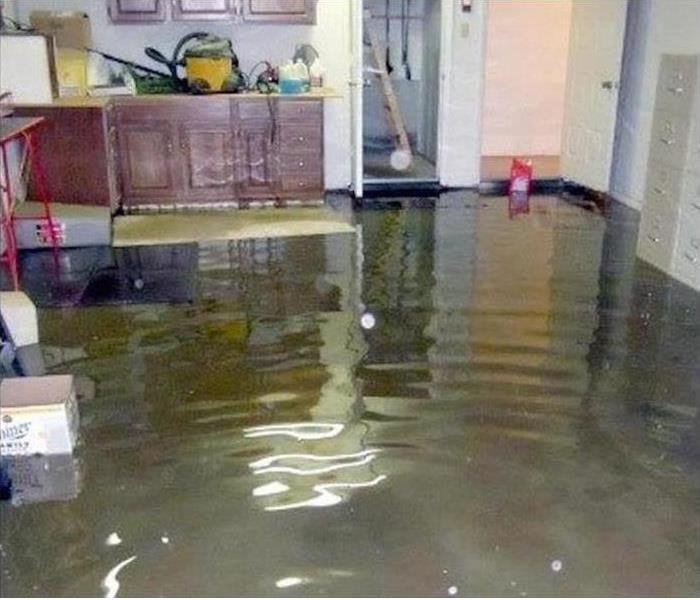 SERVPRO of Bloomington handles all water damage remediation needs.
SERVPRO of Bloomington handles all water damage remediation needs.
There are many ways to help protect your Bloomington, Indiana home from water damages. Water losses occur when water finds its way outside of the appliances you rely on to run your household’s daily needs. When we think about the causes of severe water damage to our homes, we usually think about extreme weather like a hurricane or torrential rains. But the unfortunate reality is that extensive damage is often the result of ordinary household plumbing systems and appliances that fail – and these can be just as destructive to your home as an extreme weather event.
Preventative Measures
Fortunately, there are steps that you can take to help prevent water damage from plumbing problem in your Bloomington home. It is helpful to understand some of the common causes of water damage.
These may include:
• Heating and air-conditioning systems
• Water heaters
• Valves
• Appliances
• Pipes and plumbing fixtures
How to Detect Water Damages
Water damage can often go undetected, even if the telltale signs are there. Plumbing that is housed inside the walls of your home, in less-trafficked areas like a basement or attic, or behind a cabinet or appliance, can easily go unnoticed. That’s why it’s important to check your appliances and plumbing from time to time.
- Know where the main water supply enters your home, locate the main shut-off valve and make sure it’s functioning properly.
- If you will be away from home for an extended period, consider shutting off the water supply, but consult with a heating professional first to understand if doing so will compromise any other systems in your home. Maintain a temperature of at least 55 degrees in your home. Also, if your home is protected by a fire sprinkler system, do not turn off the water to this system, and maintain sufficient heat to prevent a freeze-up.
- Consider having your air-conditioning system inspected regularly by a professional. Check around the unit for indications of leaks. Check the drain lines annually and clean them if they are clogged. Change the air filter annually at a minimum.
- Inspect water heaters, showers, tubs, toilets, sinks, dishwashers, refrigerators and washing machines annually, and have them repaired if there are signs of leaks or corrosion. Be sure to include supply lines, hoses, connections and fittings in the inspection.
- Check caulking around showers, bathtubs, sinks and toilet bases, and make repairs as needed.
- If your refrigerator has an ice machine or water dispenser, check the hose between the wall and the refrigerator to determine if it is pinched or stressed. Also look for signs of leaking or wear and tear.
- Check exposed plumbing (pipes, valves, etc.) for signs of leaking or corrosion. Have any pipe damage fixed immediately to prevent more costly repairs in the future.
For any questions or concerns about water damage in your home, call SERVPRO of Bloomington at (812) 824-2027.
Water damage due to a plumbing issue in your home can be life-changing. But there are some common signs that homeowners can look for, and steps they can take, to help avoid a major water issue at home.
Consider this example:
A homeowner and his family head off for a three-week vacation. While they’re away, a minor toilet leak grows, until it reaches a pace of three gallons of water per minute. By the time the homeowners returned from their three-week vacation, the unaddressed leak had poured more than 30,000 gallons of water into their home. The water ruined furniture, fixtures and irreplaceable family valuables, and rendered the property virtually uninhabitable for an extended period of time.
But this is just a cautionary tale. The following guidance is meant to help you learn about the potential water issues from common plumbing problems and how you can take steps to help prevent disaster.
Causes For Plumbing Problems
Plumbing issues can occur anywhere in your home. Frequently, lack of maintenance is the root cause of these problems. However, other causes can include:
- Manufacturing and design defects.
- Installation errors.
- Exposure to cleaning products (for example, by storing chemicals under the sink or by cleaning surfaces of plumbing components).
If caught early, many plumbing problems can be addressed before serious damage occurs. For this reason, regular inspection of your home’s visible plumbing parts can be critical. Knowing the lifespan of parts and appliances is also important, as is properly maintaining the other parts of your home and its features and systems.
Signs to Look For
Want to help prevent plumbing complications from damaging your home and potentially resulting in expensive property damage or loss? Start by visually inspecting your plumbing on a regular basis. Look for drips and slow leaks. Be sure to check the areas surrounding your pipes as well. If you see water damage on cabinetry or other nearby materials, there may be an active leak that you’ll want to locate.
Your entire home plumbing system may not be visible, but there are certain places in your home where you can readily inspect plumbing components:
- Under sinks and washtubs.
- Inside access panels near showers, sinks or appliances.
- Attachments to toilets, water heaters and appliances.
- Basements and crawl spaces.
You will want to look at any piping, valves and fittings in the areas listed above. Leaks are most common at connection points, so pay close attention to the plumbing connections on faucets, washing machines, refrigerators, dishwashers, water heaters, water filtration systems, shut-off valves and toilets. Your home’s piping system may also have multiple connections between various sections of pipe. Appliances and fixtures themselves can cause problems, so be sure to inspect those as well, and keep up with any regular maintenance recommended by the manufacturer.
The signs of a problem will vary by component. For example, problems in copper piping may look very different from problems in PEX, a common type of plastic piping. In general, you want to look for signs of corrosion, cracking, hazing, discoloration and mineral deposits from a water leak.
SERVPRO of Bloomington. Your leader in commercial and residential water damage restoration. We make fire and water cleanup and restoration, "Like it never even happened."
(812) 824-2027.
Water and Flooding Can Damage Your Bloomington Home or Business
8/17/2022 (Permalink)
When water damage hits your home be sure to give SERVPRO a call right away. The importance of getting SERVPRO on site is that we can prevent further damage from being created from the damage being untreated.
There are a variety of safe practices to help prevent water damages to your home or business. Such as cleaning out gutters, checking your sump pump, clearing out drains and ditches, and keeping your hoses disconnected when not in use.
But, what do you do when an accident happens that you couldn’t have prevented such as broken pipes, sewer backup or heavy rainfall? The first 24 hours after a loss is crucial. This is how long it can take for mold to start developing, even with the smallest amounts of water.
Make sure to give SERVPRO of Bloomington, IN a call at 812-824-2027 to get a specialized team out to your property as soon as possible so they may start the mitigation process.
SERVPRO of Bloomington. Your leader in commercial and residential water damage restoration. We make fire and water cleanup and restoration, "Like it never even happened."
Does Insurance Cover Your Bloomington Indiana Water Loss?
8/7/2022 (Permalink)
When it comes to water in the home, some leaks are small and are easily cleaned up and fixed by the homeowner or a local handyman. But, what do you do when the project at hand is too much to handle on your own?
Give SERVPRO of Bloomington, Indiana a call at 812-824-2027 and let our water mitigation experts get your place back to its pre-damaged condition faster.
You may be asking if your insurance will cover a claim like this. Let one of our skilled project managers help walk you through the claims process and give you a better peace of mind. Not to mention our skilled team members use the most advanced equipment to extract and dry out all affected areas in the home.
Its important to not let water damage sit over time, by calling in our professional team to take care of it can save you in the long run from further damage.
SERVPRO of Bloomington. Your leader in commercial and residential water damage restoration. We make fire and water cleanup and restoration, "Like it never even happened."
Water Damage in Bloomington, IN
7/21/2022 (Permalink)
Noticing a small water spot around a baseboard or some bubbling in your ceiling may not seem like a big deal, but knowing when to call a professional can make a huge difference in the overall quality of your home or business. Giving one of our trained technicians at SERVPRO of Bloomington, Indiana a call at 812-824-2027 could save you in the long run.
Leaks can carry contaminants that can be dangerous to anyone who comes into contact with it. Also, depending on the area, water damages could become an electrical hazard or even cause structural damage to the property. If not treated within a timely manner, said water could cause mold and mildew issues, which once again can be dangerous to those occupying the building. Give us a call at the first site of any size water damage to get a trained professional out to look at the potential cause of the leak and prevent any further damage to the structure.
Your First Call When Water Damage Occurs
12/27/2021 (Permalink)
Your home or business has been hit with a pipe burst or flooded from rains, do you know what your next step is? Flooding is a serious issue as it can have lasting effects on your home or business from structurally to affecting the air quality if not dried properly. Make that first call to SERVPRO of Bloomington.
With over 50 years in the water restoration industry SERVPRO offers best in class service with the best in equipment and trained and certified staff.
It is imperative following any type of water event in your home or business to call SERVPRO to help begin the drying process. Water can saturate the structure further aggravating the damage done to the property.
We also have leading edge technology to help dry in places where demolition isn’t necessary to help save money and save on time. We also carry a full line of products that can help dry hardwood floors without replacing them.
50 years strong and the next 50 years look even stronger as we continually make improvements to the services we offer. Got water damage? Give us a call today at 812-824-2027.
Commercial Water Damage in Bloomington, IN
7/8/2021 (Permalink)
Is your business prepared if it gets flooded? Recently our crews were called out to a large commercial structure that sustained water damage from a fire sprinkler system failure. With our 24-7-365 service you can rest assured SERVPRO of Bloomington will be on scene quickly to get the business back in operations.
We know the importance of getting your business back to business as quickly as possible as time is certainly money. Using state of the art and industrial strength equipment in addition to having the best in trained staff to handle any disaster.
We also have large desiccants available that are used to take moisture out of large structures to help lessen drying time. In addition these large desiccants are generator powered so if the power is out we can still dry out the building.
Find out more about how SERVPRO of Bloomington can handle your fire, water or mold damage needs with a call to 812-824-2027.
Heavy Rains in Elletsville, IN
7/3/2021 (Permalink)
Heavy rains with failed sump pumps have been a major concern for home owners in the area. There are a few ways to help keep water out of your basement but it's always good to know the water damage experts at SERVPRO of Bloomington are here just in case.
A few things to check before the next big rain include:
- Make sure drainage, gutters and downspouts are cleared of any debris.
- Adding extensions off of downspouts to ensure water is flowing away from your home
- Testing sump pumps at least once a month to make sure they are still working
- Make sure sump pump plumbing is also ejecting water far away from the house
- Making sure all debris is cleared from the roof and make sure to have your roof inspected annually.
Of course if your water takes on any water from flooding from the inside or out, SERVPRO of Bloomington is here to help. Got water damage? Call 812-824-2027.
Water Damage in your Bedford, IN Home Or Business
4/17/2021 (Permalink)
Water damage can strike at any time of the day, that's why the Professionals at SERVPRO are on call 24-7 for your emergencies. From homes, apartments to commercial structures, no water is too big or too small for SERVPRO to handle. With state of the art water extraction equipment to industrial strength fans and dehumidification equipment we have the equipment to get you dry in no time.
We are also able to take care of some water damages with the use of the newest technology without having to remove flooring or walls through a unique process. Our trained staff has been thoroughly educated on knowing the signs of water damage as well as the best and least invasive ways possible to remove the water.
If you have any questions, or have had water damage, please contact your local office at 812-824-2027.
How To Tell If Your Water Heater Is Failing
3/29/2021 (Permalink)
Its something we never really check on yet we depend on it every day. It's our water heater. We've recently seen several calls for water and even mold remediation after a water heater failure.
From a lack of hot water, small leaks and even a whole house full of water, there are several ways to know before it goes:
- From no hot water or inconsistent hot water availability
- You notice any water around the water heater
- Reduction of hot water flow
- Odd odors or discolored water
- Any sounds out of the ordinary
- Older water heater units
Unfortunately what we see the most is large amounts of water into the home from a failed water heater.
It's not only the water that is the concern, it's the chance of mold forming in those areas as well.
Water Damage In Your Home
2/15/2021 (Permalink)
When is a good time to inspect your water system in your household? Well it's pretty common that no one really checks in on it until after there is an issue with it. In some cases it's pretty difficult to be able to inspect every linear foot of your water pipes, but there are a few ways to check.
Pay close attention to your water bill as it may show excessive water usage or above normal usage
Unusual water found in or around your crawl space
Damp floors or water seeping up from the floor
Mold forming inside your home around baseboards or around cabinets
Check on water heaters, and consider replacing if old
Best thing to do once you discover water in your home or business? Call the professionals at SERVPRO for a free damage estimate and inspection at 812-824-2027 to get the water extracted from your home.
Have You Checked Your Gutter System Lately?
10/27/2020 (Permalink)
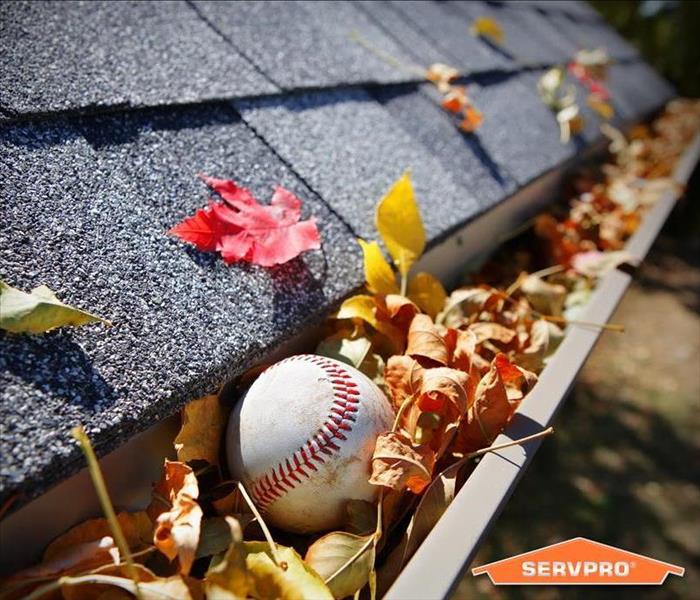 Clogged Gutters
Clogged Gutters
Now that we are well into the fall season, SERVPRO of Bloomington wants to remind homeowners about an important functioning item we tend to overlooked each year, your gutters.
Although you may not think about it, the state of your gutters can affect many other areas of your family's property, which includes your roof and foundation. If your gutters fail to function they way they are intended to do they can wreck havoc on your home or business . The most common problem that homeowners face with their gutters is that they fail to drain or channel excess rainwater far enough away from your foundation. That excess water can back up under your home's foundation or into your basement. If rain water doesn't travel through your gutters freely, it's most likely because the gutters are clogged with leaves or debris. This is especially common during this season when trees are dropping their leaves. If you have clogged gutters it can often lead to costly foundation repairs that can cost thousands of dollars. Having your gutters regularly cleaned (at least once or twice a year) can prevent a major water damage from happening to your property.
if you are concerned about your gutters not functioning property, SERVPRO of Bloomington encourages you to have them inspected by a qualified company to avoid any future water damage from gutters that are clogged.
When water backs up into your basement our foundation, it very well may be a gutter system that is not functioning properly. Be sure and call the cleanup team that is "Faster To Any Size Disaster" in the event water damage strikes your home or business.
Spring Time Inspection
3/18/2019 (Permalink)
As spring is getting closer, more rain seems likely so it might be a great time to inspect your gutters to see if they might need some maintenance. Gutters full of debris can cause a lot of water damage. You should inspect them frequently. If they are full and clogging the downspouts, the overflow of water could be going in all the wrong places such as your walls. Water damage can become a major issue if not handled quickly. Checking things such as the guttering and outdoor water spickets can help prevent huge problems as well as prevent huge expenses. Regular maintenance is key to preventing water damage on the outside. For people with outdoor pools and fountains, checking all hoses and connectors is a great idea and should be a part of your spring time inspection as well! We can't always prevent all types of water damage but the ones we can will help to minimize the possibility! Take a little time now for your own peace of mind! We see a lot of water damage at SERVPRO that could have been prevented! Create your own spring time inspection list and enjoy your spring!
Working with the damaged area
2/20/2019 (Permalink)
 Portion of Train Town!!!!
Portion of Train Town!!!!
We have seen a lot of different situations and each has its own plan to correct the issue. In this case, we have water damage at a residence due to flooding. The residence has an extremely detailed and in depth train community. The entire setup of train and the town are up on stilts. Extracting the area with an RX20 was not an option due to all the legs from the train town every few feet. It was not possible to get more than a wand in between the legs, and it would have been almost impossible to relocate the entire setup. Our technician had to do some seriously planning. He used a a special mix of our fans and the dehumidifiers set to not disturb the client's hard work. Although complicated, we at SERVPRO kept the client and their town right on track!
Flooding in Monroe County
2/13/2019 (Permalink)
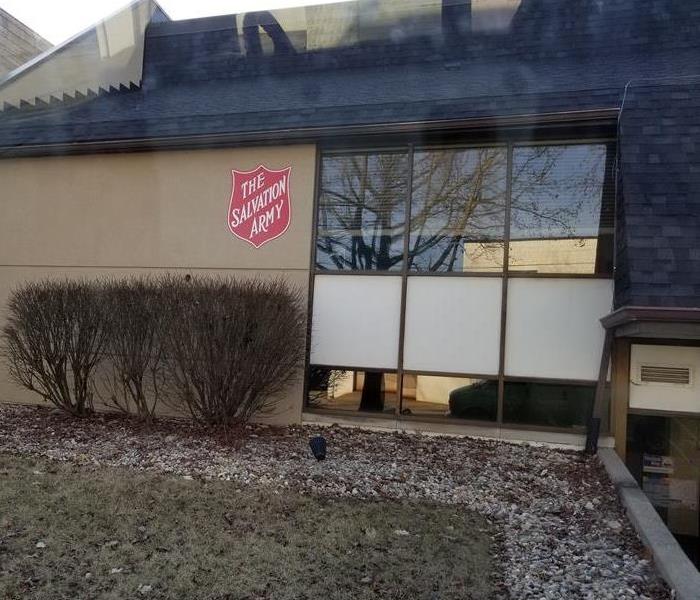 Salvation Army
Salvation Army
Our team spent Saturday at the Salvation Army. The Severe flooding happening in Monroe County has taken quite a toll on the area. The flooding hit so many places here and in the surrounding area. We have been very busy. SERVPRO, we are here when you need us!!
Is it any wonder ?
1/23/2018 (Permalink)
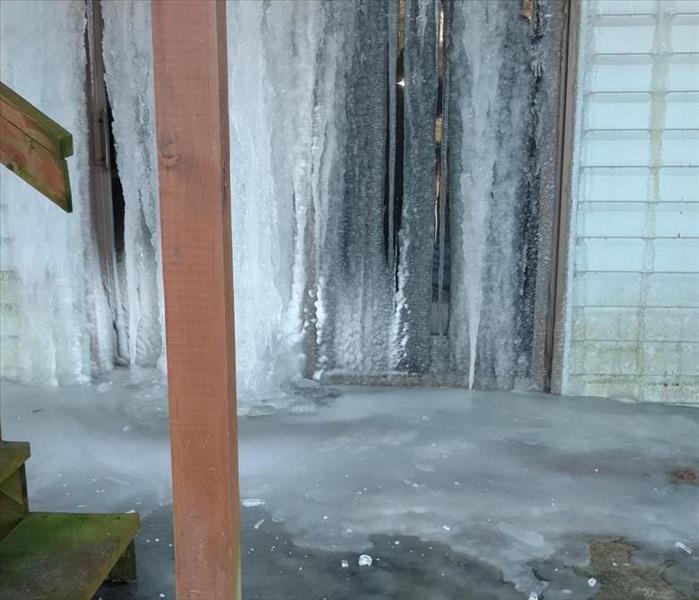 Can you say Water damage? We can.
Can you say Water damage? We can.
Here in Indiana, the weather is a huge issue in the winter.
General Information
1/18/2017 (Permalink)
24 Hour Emergency Water Damage Service
Category: Water Damage
Photo Caption: SERVPRO of Monroe, Lawrence, Owen, Greene and Martin counties provides 24 hour fire and water damage restoration service in our 5 counties
SERVPRO is available 24 hours a day for water emergencies, large or small. When you are dealing with water damage, immediate action is crucial. A delay of just a few hours can greatly increase the severity of the water damage.
We Answer the Phone Ready to Help
Call Today - 812-275-2244
We understand that when you call us, you may be feeling confused, stressed, and vulnerable. You need an expert to guide you through this crisis. SERVPRO has the specific water damage training and experience to help you through this tough time. We specialize in water damage restoration—in fact, it's the cornerstone of our business.
What to Expect
When you call, we will ask several questions regarding your water damage emergency. These questions will help us determine what equipment and resources to bring, including how many trained SERVPRO Professionals may be needed.
Our SERVPRO Representative will ask several questions:
Your name and contact information
Your insurance information (if applicable)
The street address of the water-damaged home or business
When did the flooding or water damage occur?
What caused the water damage (if known)?
Is there electricity available (on-site)?
About SERVPRO of Monroe, Lawrence, Owen, Greene and Martin Counties specializes in the cleanup and restoration of residential and commercial property after a fire, smoke,water damage event, sewer backups and vandalism. Our staff is highly trained in property damage restoration. From initial and ongoing training at SERVPRO’s corporate training facility to regular IICRC-industry certification, rest assured our staff is equipped with the knowledge to restore your property.
We are IICRC certified and perform background checks on all employees
 SERVPRO of Bloomington responded quickly to dry this newly installed hardwood court at a local school.
SERVPRO of Bloomington responded quickly to dry this newly installed hardwood court at a local school.



 24/7 Emergency Service
24/7 Emergency Service







